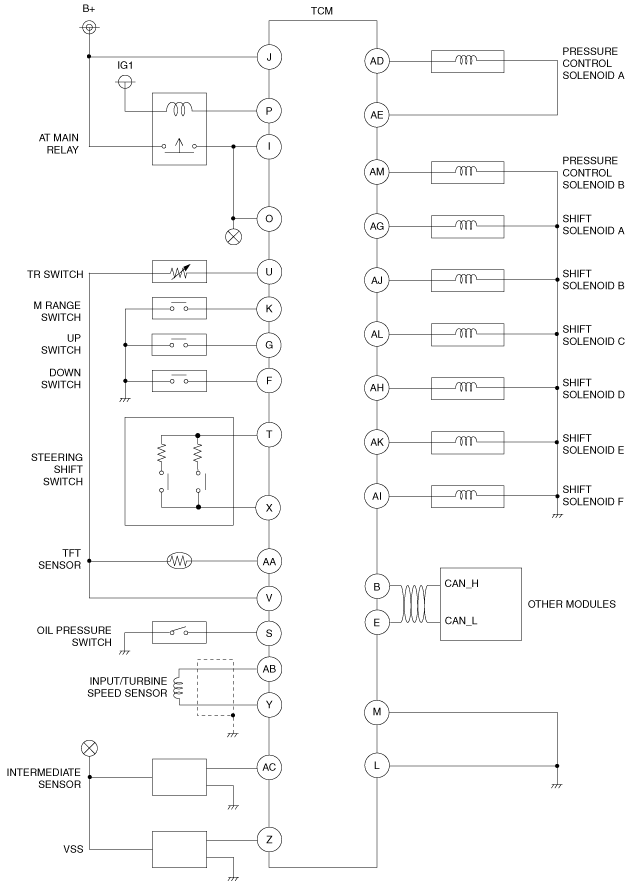 |
am3zzn00001841
TCM OUTLINE [FS5A-EL]
id051721286400
Wiring Diagram
am3zzn00001841
|
Function
|
Item |
Outline |
|---|---|
|
Automatic shift control
|
• The TCM selects the most suitable automatic shift diagram on the results of the driving range and driving mode judgements.
• Based on the automatic shift diagram, the TCM controls the output devices to perform shifting according to the vehicle speed and the accelerator pedal depressing amount.
|
|
Manual shift control
|
• In M range, the TCM selects the manual shift diagram.
• Based on the manual shift diagram, the TCM controls the output devices to perform shifting according to the vehicle speed and the driver’s up-shift/down-shift operation.
|
|
Direct mode control
|
• Shifts temporarily by using the steering shift switch even when the selector lever is in the D range.
|
|
Slope mode control
|
• Climbing is determined based on the engine torque and the vehicle acceleration, and the shift gear is controlled to realize smooth vehicle driving.
|
|
TCC control
|
• The TCM selects the TCC diagram based on the shift control results.
• Based on the TCC diagram, the TCM controls the output devices to engage the TCC according to the vehicle speed and the accelerator pedal depressing amount.
• Smooth TCC control, which engages the TCC gradually, has been adopted to reduce the shock when the TCC engages.
|
|
Slip control
|
• When the accelerator pedal is fully released for deceleration, power transfer efficiency has been improved through a slip control on the torque converter set under a specified range of conditions. As a result, fuel economy, emission performance, and ride comfort have been improved.
|
|
Line pressure control
|
• The TCM adjusts the pressure control solenoid pressure by driving the pressure control solenoid A according to the accelerator pedal depressing amount, vehicle speed, ATF temperature and gear position.
• As a result, the line pressure is controlled very accurately and closely.
|
|
Direct electric shift control
|
• The TCM determines the optimum clutch engagement pressure and drives the solenoid valves based on input signals in accordance with the vehicle driving conditions including the engine torque.
• By driving the solenoid valves, and performing the electronic control of the clutch engagement pressure directly through the TCM, minute hydraulic control, which could not be obtained by the clutch engagement pressure control with the accumulator, is obtained.
|
|
Feedback control
|
• When shifting, real-time feedback correction of the clutch engagement pressure is operated by the solenoid valves so that the speed change of the turbine shaft (change of the turbine rotating speed) matches the predetermined target value.
|
|
Engine-transaxle total control
|
• When shifting, engine output torque is reduced temporarily and the clutch is engaged smoothly by engine ignition timing retard control to reduce the fluctuation of the output shaft torque during shifting.
|
|
On-board diagnostic system
|
• The TCM detects malfunctions in the transaxle while driving.
• Minimum vehicle drivability is obtained by changing the signals that are determined to be malfunctions by the malfunction detection function to the preset values, and limiting TCM control.
|
Relation Chart
am3zzn00003461
|